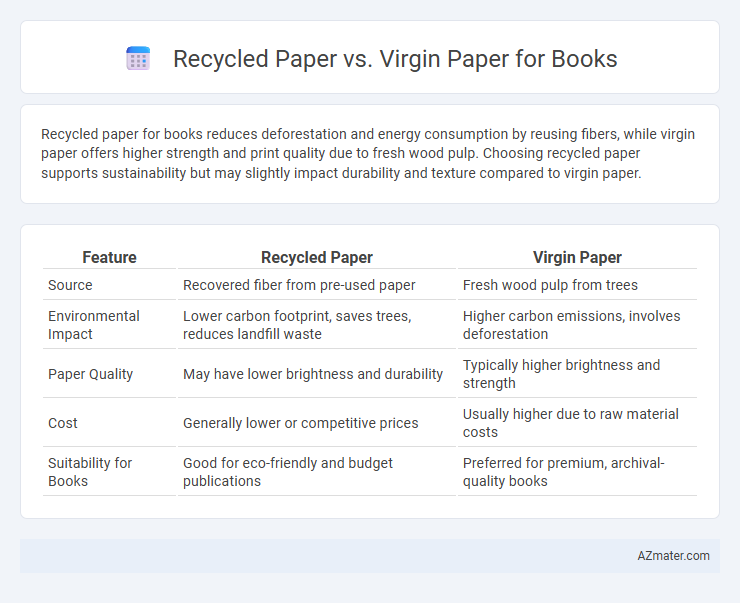Recycled paper for books reduces deforestation and energy consumption by reusing fibers, while virgin paper offers higher strength and print quality due to fresh wood pulp. Choosing recycled paper supports sustainability but may slightly impact durability and texture compared to virgin paper.
Table of Comparison
| Feature | Recycled Paper | Virgin Paper |
|---|---|---|
| Source | Recovered fiber from pre-used paper | Fresh wood pulp from trees |
| Environmental Impact | Lower carbon footprint, saves trees, reduces landfill waste | Higher carbon emissions, involves deforestation |
| Paper Quality | May have lower brightness and durability | Typically higher brightness and strength |
| Cost | Generally lower or competitive prices | Usually higher due to raw material costs |
| Suitability for Books | Good for eco-friendly and budget publications | Preferred for premium, archival-quality books |
Introduction to Recycled and Virgin Paper
Recycled paper is made from post-consumer waste materials, reducing the demand for new raw timber and conserving natural resources. Virgin paper, derived directly from fresh wood pulp, offers high strength and brightness but has a larger environmental footprint due to deforestation and energy consumption. Both types are used in book production, with recycled paper favored for sustainability and virgin paper preferred for premium quality printing.
Environmental Impact: Recycled vs Virgin Paper
Recycled paper significantly reduces deforestation and lowers greenhouse gas emissions compared to virgin paper, as it utilizes existing fiber rather than harvesting new trees. The manufacturing process for recycled paper consumes less water and energy, decreasing the overall environmental footprint of book production. Virgin paper, while often providing higher strength and brightness, contributes to habitat loss and greater pollution due to the intensive logging and chemical treatments required.
Energy and Water Consumption Comparison
Recycled paper production consumes up to 60% less energy compared to virgin paper manufacturing, significantly reducing carbon emissions during book production. Water use in recycled paper processes is typically 45-70% lower, minimizing environmental impact on freshwater resources. This efficiency makes recycled paper a sustainable choice for publishing, balancing resource conservation with quality book printing needs.
Paper Quality Differences
Recycled paper for books often has a slightly rougher texture and lower brightness compared to virgin paper, which offers a smoother finish and higher whiteness, enhancing print clarity. Virgin paper is made from fresh wood pulp, providing greater strength and durability, while recycled paper fibers are shorter and may compromise the paper's longevity. However, technological advancements have improved recycled paper quality, making it increasingly acceptable for standard book production without significant compromise in print quality.
Printing Performance and Durability
Recycled paper often exhibits slightly lower printing performance due to its rougher texture and higher lignin content, which can affect ink absorption and clarity compared to virgin paper. Virgin paper, derived directly from wood pulp, provides superior durability with stronger fibers that resist tearing and yellowing over time, making it ideal for long-lasting books. However, advancements in recycled paper processing have significantly improved its quality, narrowing the gap in print sharpness and lifespan for many publishing applications.
Cost Analysis: Recycled vs Virgin Paper
Recycled paper typically costs 10-30% less than virgin paper due to lower raw material expenses and reduced energy consumption in production. Virgin paper, made from fresh wood fibers, often demands higher prices reflecting deforestation costs and intensive processing. Publishers prioritizing budget efficiency frequently opt for recycled options to minimize material costs while supporting sustainability goals.
Availability and Sourcing Challenges
Recycled paper for books faces variability in availability due to fluctuating collection rates and quality inconsistencies, impacting supply stability. Virgin paper sourcing relies heavily on timber from sustainable forests, though regional logging restrictions and environmental regulations can limit its accessibility. Both options present challenges in balancing environmental goals with reliable procurement for large-scale book production.
Consumer Perceptions and Trends
Consumers increasingly favor recycled paper for books due to its environmental benefits, perceiving it as a sustainable and eco-friendly choice that reduces deforestation and carbon footprint. Despite concerns about the quality and durability of recycled paper, advances in production technology have significantly improved its texture, brightness, and longevity, narrowing the gap with virgin paper. Market trends indicate growing demand for recycled paper books among environmentally conscious readers, influencing publishers to adopt greener practices and promote transparency about sourcing materials.
Certifications and Eco-Labels to Consider
When choosing between recycled and virgin paper for books, certifications like FSC (Forest Stewardship Council) and PEFC (Programme for the Endorsement of Forest Certification) ensure responsible sourcing and sustainable forest management. Eco-labels such as Green Seal and EU Ecolabel indicate reduced environmental impact, highlighting recycled paper's benefits in minimizing deforestation and waste. Evaluating these certifications and eco-labels helps publishers and consumers promote eco-friendly products without compromising print quality.
Choosing the Right Paper for Book Publishing
Selecting the right paper for book publishing involves comparing recycled paper and virgin paper based on sustainability and print quality. Recycled paper reduces environmental impact by using post-consumer fibers but may have lower brightness and durability compared to virgin paper made from fresh pulp, which offers superior print clarity and longevity. Publishers must balance eco-friendly goals with aesthetic and function requirements to choose the optimal paper type for their specific book project.

Infographic: Recycled paper vs Virgin paper for Book
 azmater.com
azmater.com